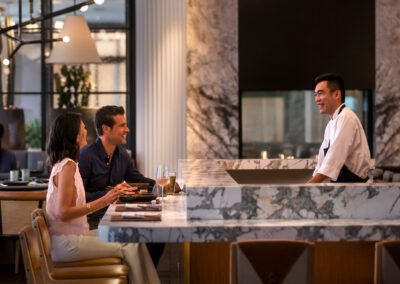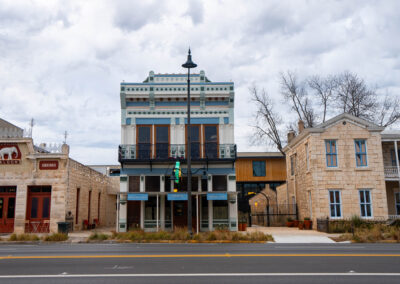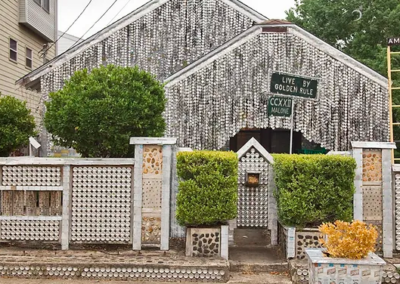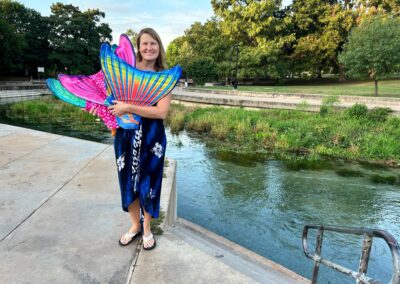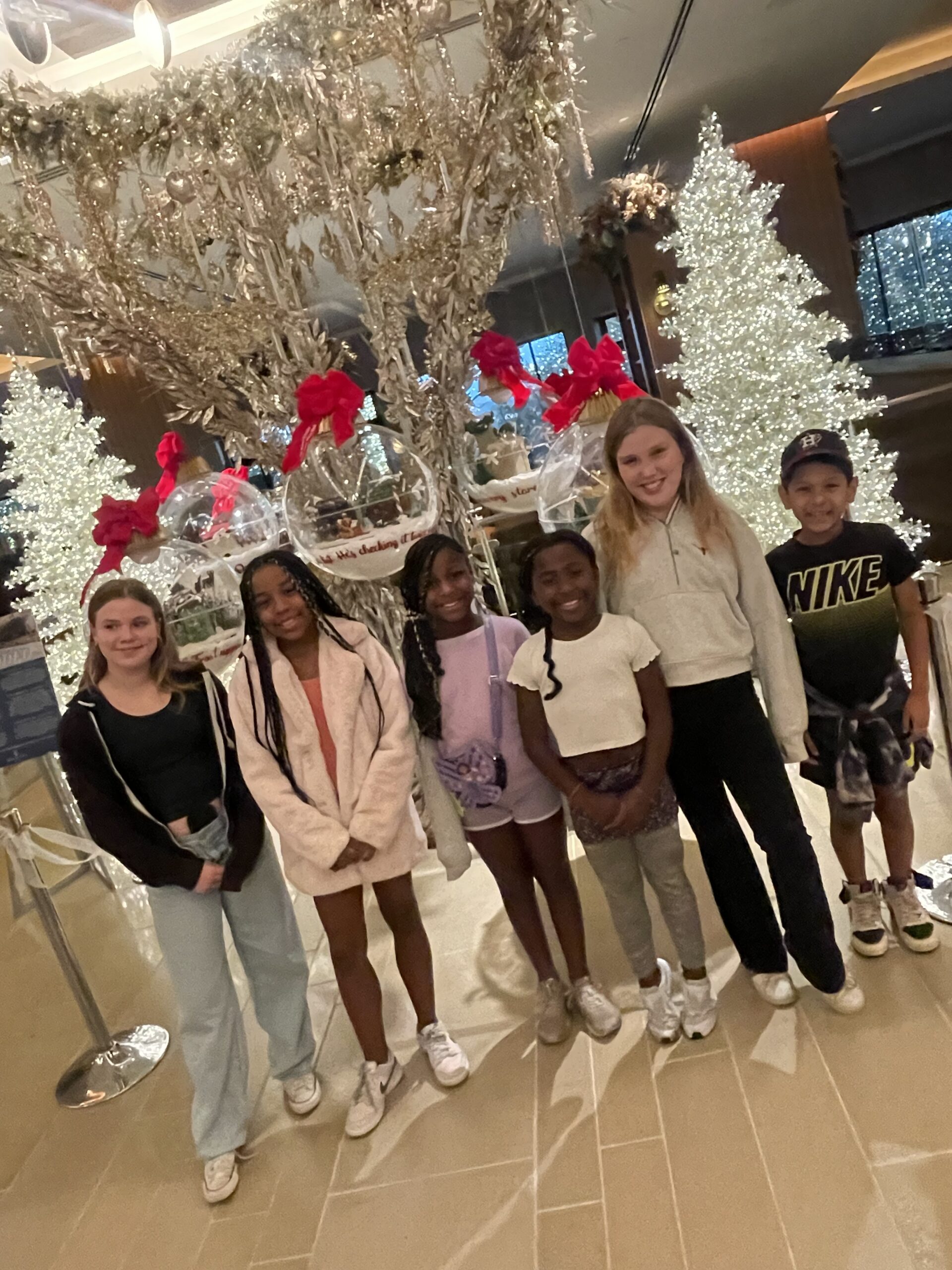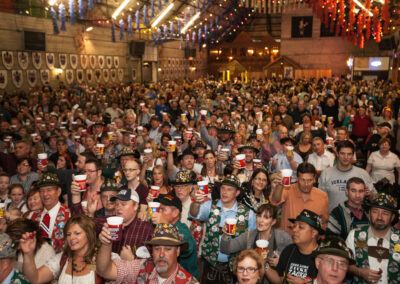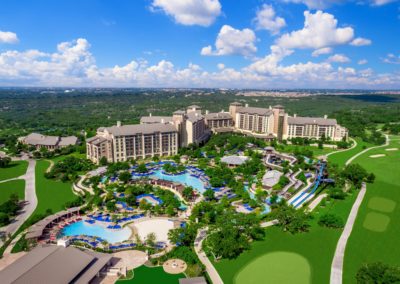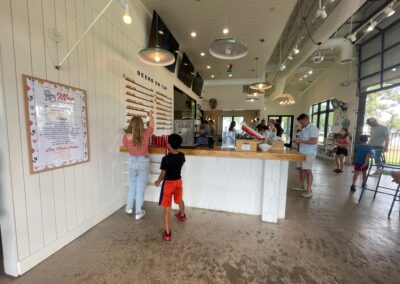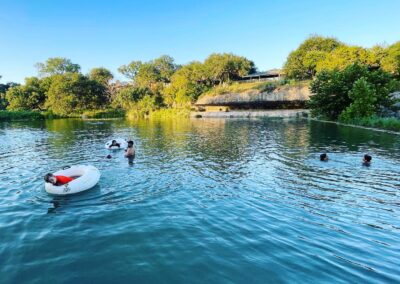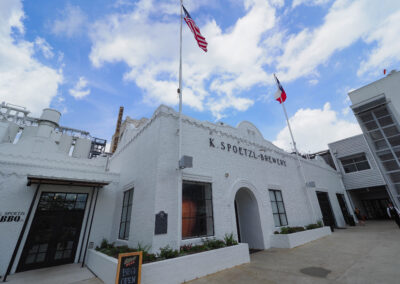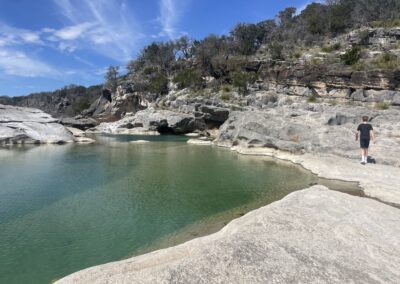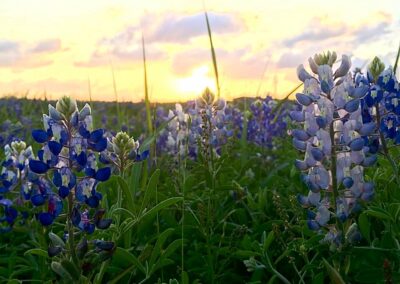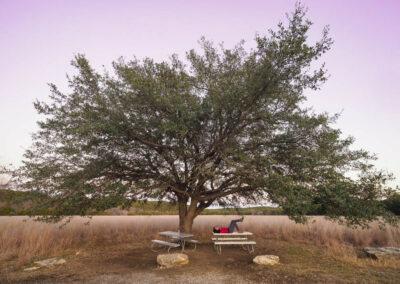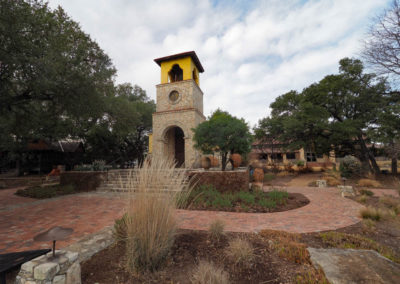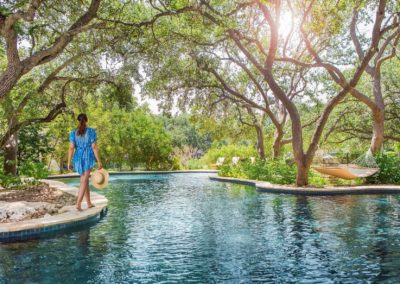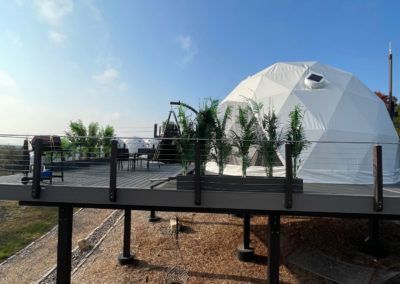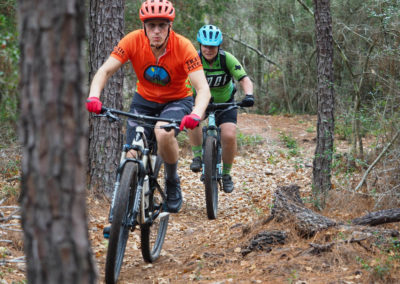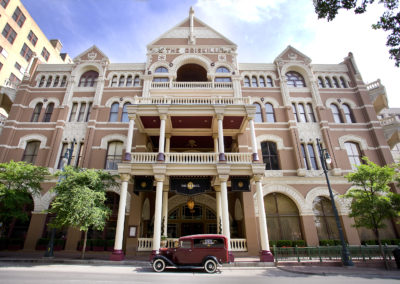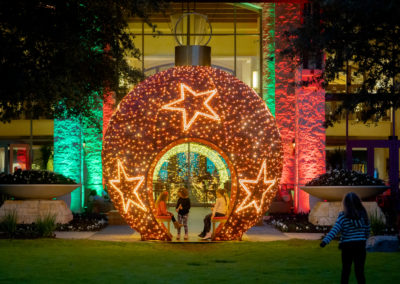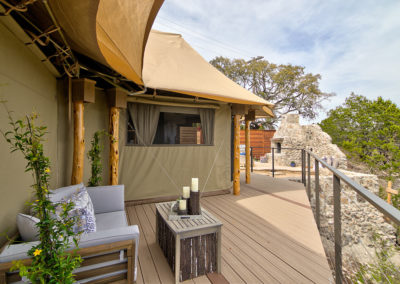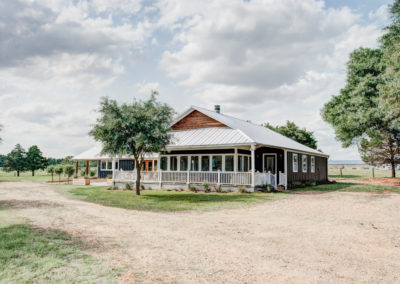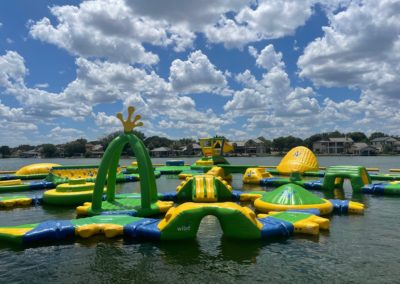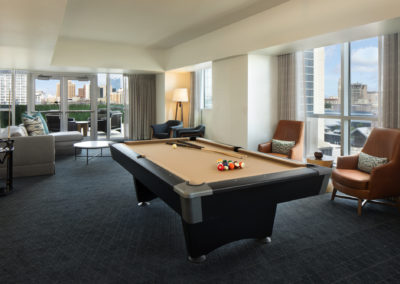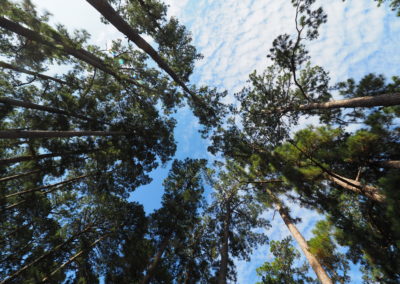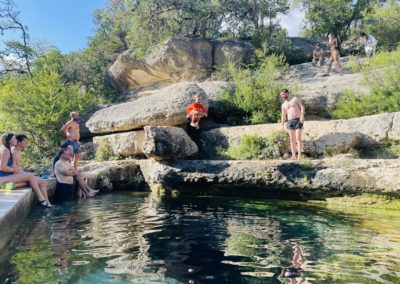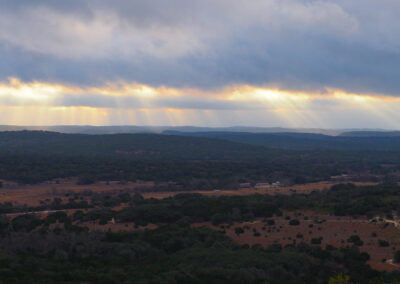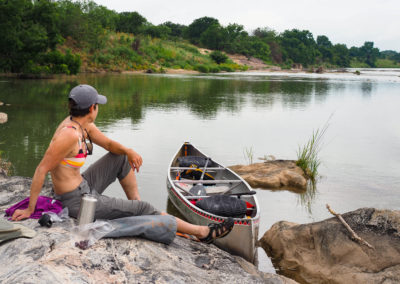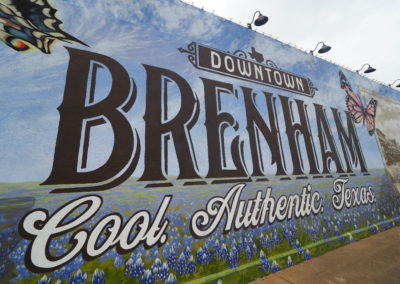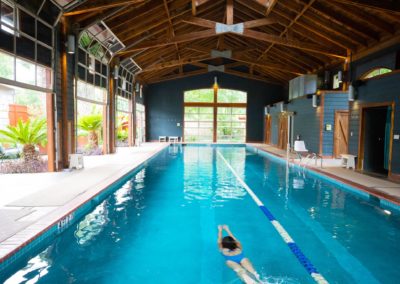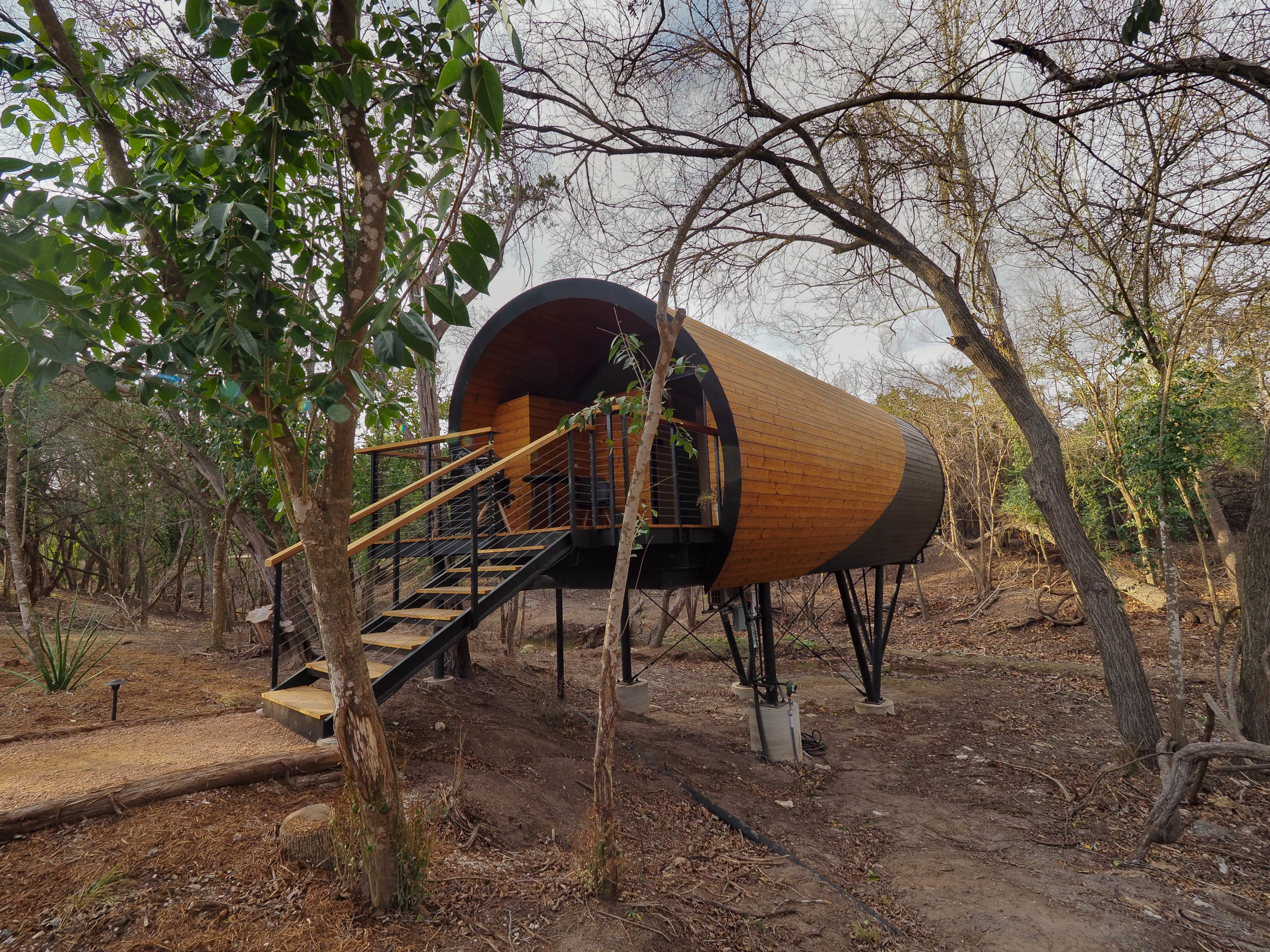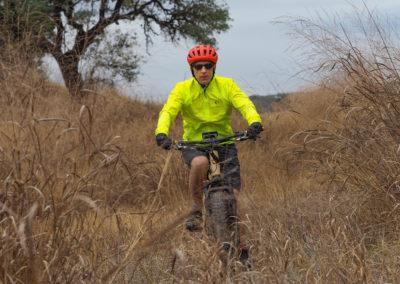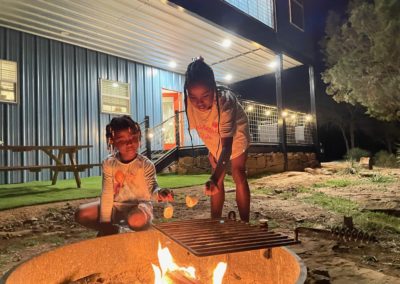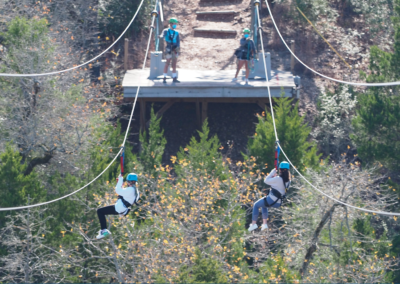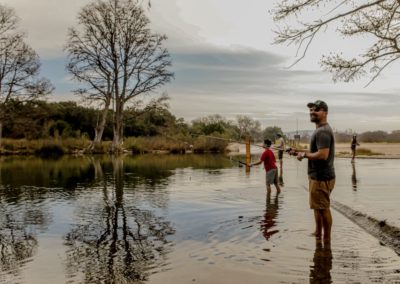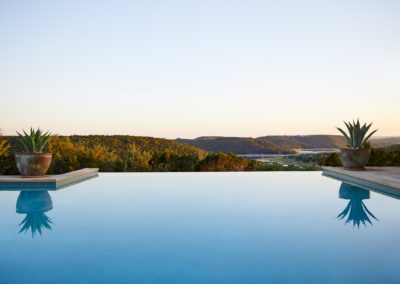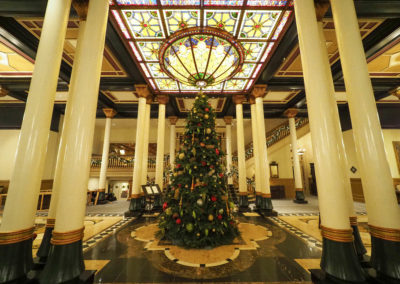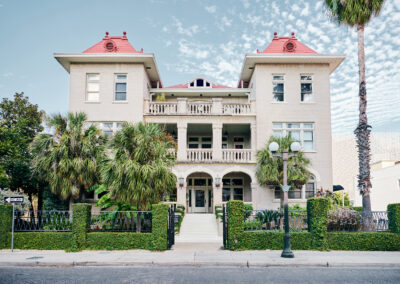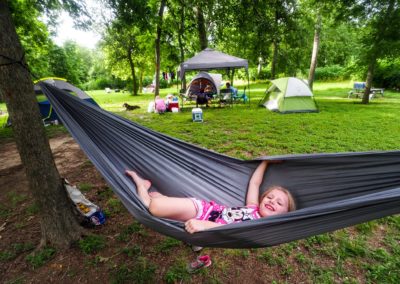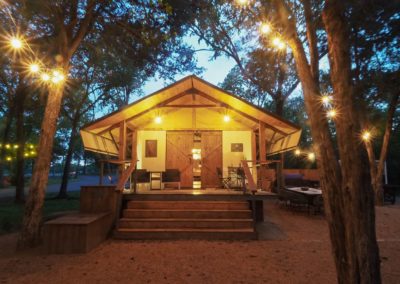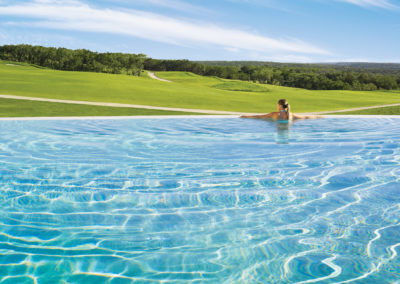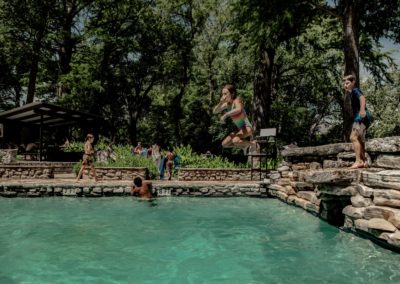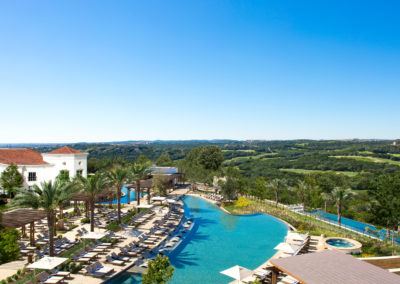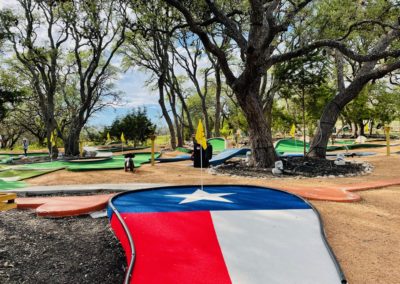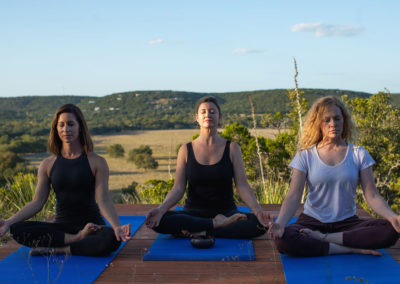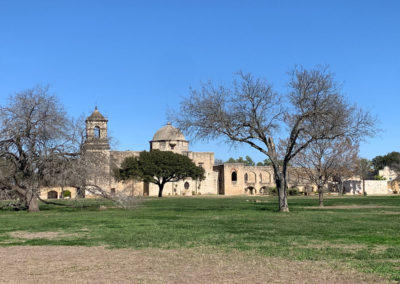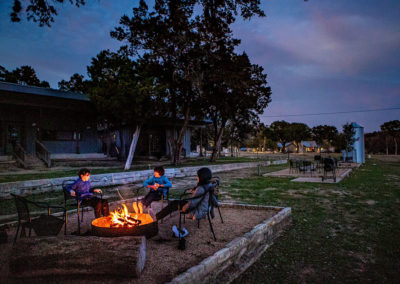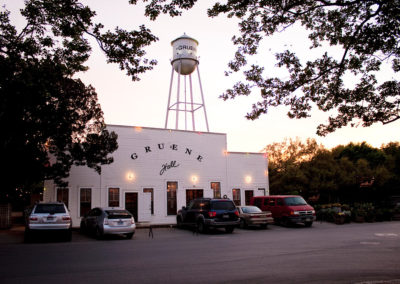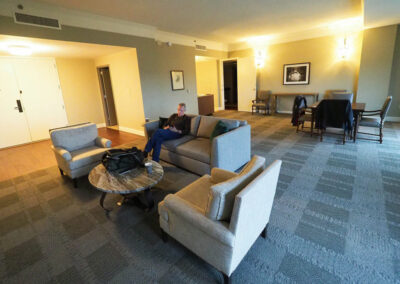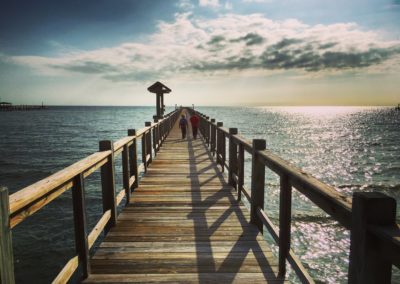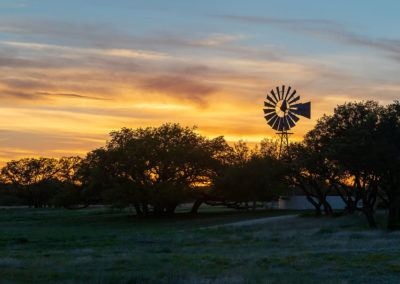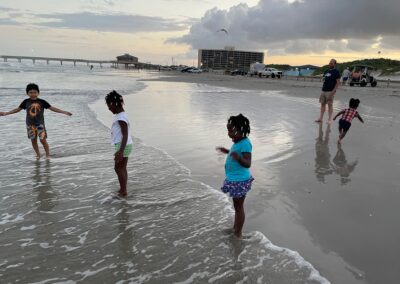Our youngest son cautiously steps onto the wooden planks of a swaying suspension bridge, gripping tightly to the rope railings as his older brother bounds across to check out what awaits on the other side. This aerial catwalk, floating above bright green treetops, transports us from our ground-level reality to an imaginative treehouse perched up in the air that looks like something out of a fantasy. (I’m instantly reminded of Disney’s 1960 film Swiss Family Robinson I watched as a kid.)

The Nest treehouse is perched high above a beautiful creek ravine. Photo by Mauri Elbel.
It’s called The Nest, and it’s where we get to bunk up for the night. If you’ve ever wondered what it’s like to sleep in the trees, you’ll find the answer at Cypress Valley, where arboreal adventures unfold in the heart of the Hill Country. Just 30 miles outside of Austin’s bustle and an entire world away, it seems fitting that we’re here in a treehouse, wrapped up in the arms of Mother Nature, on Earth Day.
Built out across the branches of towering cypress trees and hovering high above a verdant valley, The Nest consists of a series of playful viewing pods, a full kitchenette and dining room, an outdoor shower, a private bathhouse with a full-flush toilet, and a charming two-bedroom suite featuring round pallet-walled rooms and a cozy nook perfect for reading and playing board games––everything is linked together by suspension bridges, steep steps and ladders.

The Nest, which sleeps four guests regularly, but can accommodate up to six using the convertible bean bag chair, is designed with an emphasis on ‘up-cycling’ and biomimicry. Contributed by Cypress Valley.
It’s the largest of five one-of-a-kind luxury treehouses nested high in the enormous cypress trees that rise up from the sprawling Spicewood property. Some of the trees, which range between 50 to 150 feet tall, are estimated to be between 500 and 600 years old.
We remain drop-jawed and speechless as we playfully explore this magical treehouse with our two boys, ages 10 and 12 (children must be at least 10 years old to stay in the treehouses so we left little sister behind with Grandma). Surrounded by treetops as far as the eye can see, staying in this eco-friendly treehouse allows us to appreciate nature from a birds-eye view. Tranquility flourishes out here––in fact, the only sounds piercing through the silence are birds chirping, water trickling into the creek ravine below and the continual oohs and ahhs coming from our kids, in awe of each new discovery revealed at every turn and climb.

The Nest treehouse includes two cozy and comfortable round-walled bedrooms perfect for families. Photo by Mauri Elbel

The charming twin room in The Nest treehouse features stained pallet walls and wrap-around bookshelves. Photo by Mauri Elbel
What exists today at Cypress Valley, a private working ranch offering unique experiences in nature, all began when Amy and David Beilharz swapped their busy lives in Austin to purchase and settle on 88 acres of undeveloped Hill Country paradise––while raising their four children.
“What we started doing originally was just for us––we were really just trying to enjoy this and be really good stewards of the property to save it for future generations,” says Amy Beilharz, Cypress Valley co-owner/co-founder who purchased the property with her husband in 1997.
Drawn to the property’s natural beauty, featuring majestic cypress trees and a spring-fed creek ravine, the Beilharz family relocated to the plot of land in 1998, with nothing but a travel trailer and a portable generator, to immerse themselves in nature, spend more time with one another, learn from the land and build everything from scratch.
“Spending time in nature is just so restorative,” says Amy. “We really just wanted to protect that creek with beautiful cypress trees. We fell in love with it.”
RELATED: 7 Family-friendly Austin-area hikes perfect for spring
From the very beginning, Amy, who has a high tech background, and David, an auto parts entrepreneur, lived by a green philosophy before it was a trend, proving that a family of six could have a small environmental impact and rely mostly on wind, water and sun without tapping into mainstream resources. They learned to conserve water and energy, invested in solar energy and rainwater collection and then wind and hydro power and created an organic farm.

Guests can cool off this summer in Cypress Valley’s lakeside pool or rope swing into the nearby lake. Photo by Mauri Elbel
“At the time, my cell phone didn’t work out here––there was no internet,” says Amy. “At first, I did homeschool the kids out here. I have a Harvard MBA, and education or being a homeschool teacher was nowhere near my vocabulary, so homeschooling was a major step. But I actually fell in love with it and realized how much fun it was. It is just nice to be outside and in nature and it was really good for all of us.”
For years, the family lived on the land privately before opening it to the public. But after some time, they decided they wanted to share it with others. They knew developing the property on a large-scale with traditional building methods would have devastated what existed, disturbing the habitat of the ravine and the complex bio-diverse inhabitants.
“We thought it was silly to just keep it to ourselves,” says Amy. “But we wanted to find a way to share it with the public without trampling it. We just wanted to do it in a way that would be light on the land.”
In 2004, David traveled to Costa Rica and experienced a canopy tour that encouraged tourists to learn about their environment while being up in the treetops. When he returned, he brought back inspirations and ideas beyond the stretch of his family’s––and everyone else’s––wildest imaginations. It seems he had found the answer to sharing the beauty of the land without trampling what existed below: to get people up in the beautiful trees.
“We were like ‘what are you talking about… flying through the trees?’” recalls Amy of those initial conversations. “There really was no reference for it. We were just breaking ground here.”
One year later, after consulting with wildlife biologists and an array of experts to collaborate on what would soon become a successful model for habitat-conserving ecotourism, Cypress Valley was flying guests over their special cypress-lined creek ravine, becoming the first zipline canopy tour in the Continental United States in 2005. Over the years Cypress Valley Canopy Tours, which has temporarily paused its operations due to COVID-19, has drawn guests from near and far looking for the chance to experience the thrill of soaring through old-growth cypress trees. Just one year after opening the canopy tours, Cypress Valley built its first treehouse in 2006 in response to guests’ requests to sleep in the trees.

Austin-based architect Travis Albrecht admires the innovative, sustainable design of The Nest. Photo by Mauri Elbel
“That first year of the canopy tours was a huge success, and people who would be up on the course would say, ‘Oh, can’t we stay overnight up here?’” recalls Amy. “I think the fun thing is that you just keep evolving with your customers. The treehouses really came from listening to our customers who wanted to stay overnight, so we created a treehouse for them to stay.”
Currently, there are five innovative and sustainably designed treehouses scattered throughout the working ranch, which includes a herd of American Bison, each designed and built by Artistree, which Amy co-founded with her son, Will, and whose mission is to protect, share and plant forests. Whether you stay in Yoki, a fully-equipped couples sanctuary with a luxurious Onsen-style soaking tub; the aerial yurt known as Lofthaven; in Willow and Juniper, which defy conventional architecture using biomimicry; or in The Nest built with families in mind, each treehouse boasts a minimalist design aesthetic that blends in with the environment and has a very light footprint on the land.
RELATED: Get away while giving back to foster children at stunning Hill Country glamping spot
With their family grown and the ranch no longer their full-time home, Cypress Valley opened up the six-bedroom Ranch House to guests in 2019, which sleeps 15 and sits on the ground but boasts a treehouse-like view from the main room. Cypress Valley also recently reopened its stunning outdoor events center, which was built right before everything shut down last year and includes a ceremony platform suspended between ancient cypress trees to form an idyllic backdrop for a fairytale wedding.
During the pandemic, at a time when people are seeking unique destinations immersed in nature, Cypress Valley has become the perfect escape. During our late April stay, we never saw another soul. But we did walk through wildflower-fringed trails, dip our toes in the circular swimming pool, lounge in hammocks and play a few competitive rounds of tetherball for nostalgia’s sake.
No one greeted us upon arrival. Instead, all in-person interactions have been replaced with emailed welcome letters chock-full of information as well as codes to access the treehouses. Our treehouse came stocked with an informative handbook with a map of the property and treehouse tips as well as suggestions to nearby attractions and restaurants. Rather than venturing outside of our treehouse for meals (we wanted to maximize our time there), we made a simple charcuterie and cheese board for dinner and brought along fruit and muffins for breakfast the next morning as we watched the sunrise and sipped hot tea and coffee (herbal teas and Cuvee Coffee steeping bags are provided in the treehouses).

Austin Travels Magazine co-founder and her 10-year-old walking across an aerial bridge at The Nest. Photo by Travis Albrecht
As a family who travels frequently, resting our heads in this treehouse was undoubtedly our most memorable stay yet––not just for our kids, but for us, too.
“Being in a treehouse is playful and creative––it sort of drops you into a place where you can access that part of your brain that is open to more possibilities,” says Amy. “For families, there are so few things that you can do where both the kids and the parents are having fun.”
I think that’s probably the best part about sleeping in the trees: It’s as magical as it sounds, for both kids and for those who want to rediscover the joy of feeling like a kid again.
If You Go

Getting there:
Cypress Valley (1223 Paleface Ranch Rd. S., Spicewood) is 30 miles and a 45-minute drive west of Austin.

Stay:
Guests can stay in Yoki Treehouse (sleeps 2-3/$600-$650), Lofthaven (sleeps 2/$500-$550), Juniper (sleeps 2/$200-$250), Willow (sleeps 2/$200-$250), The Nest (sleeps 4-6/$500-$550) and the Ranch House (sleeps 12-15/$1,050-$1,250).
Eat:
A dozen local restaurants offering everything from barbecue to pizza are within 6 miles of Cypress Valley, and dining options in Bee Cave, Lakeway and Marble Falls are 20-30 minutes away. To maximize your treehouse stay, bring pre-made or simple fixings to dine in the trees or make use of the gas grill and picnic tables on the property.
Insider tip:
Pack light––you will be carrying whatever you bring up into the treehouse. The property runs almost exclusively on solar power so turn off all lights when not in use––this will also help deter bugs and make the stars more visible at night.

Info:
Learn more at www.cypressvalley.com.








